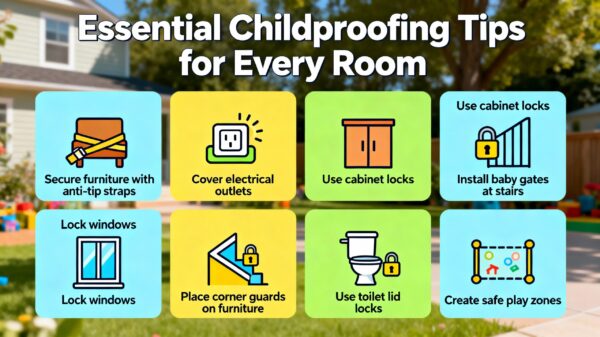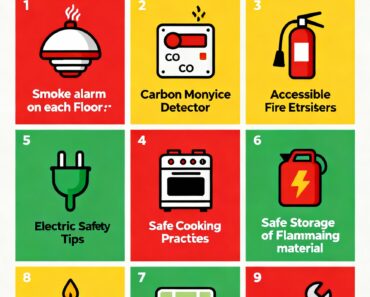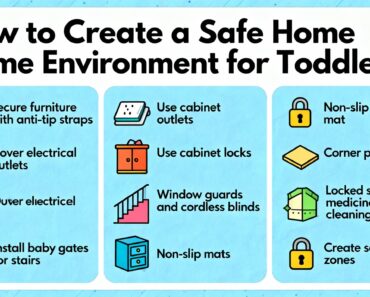Creating a safe home environment for your child involves thoughtful childproofing tailored to each room’s unique risks and challenges. Below is a comprehensive, practical guide with essential childproofing tips for every room to keep your little ones protected while giving you peace of mind.
Living Areas and Family Rooms
-
Stabilize Furniture: Secure heavy furniture like bookshelves, cabinets, and TVs to the wall using anti-tip straps to prevent tipping accidents.chs-ca+1
-
Cover Electrical Outlets: Use safety plugs or sliding outlet covers on all unused outlets to prevent electrical shocks.babylist+1
-
Manage Cords: Keep cords from lamps, blinds, and electronics short, organized, or wrapped out of reach to avoid strangulation.kidsvillepeds+2
-
Window Safety: Install window guards, locks, or wedges to stop windows from opening wide enough for a child to fall out.pampers+1
-
Eliminate Trip Hazards: Keep toys and clutter stored away in bins or shelves to prevent tripping injuries.
Kitchen
-
Secure Cabinets and Drawers: Install childproof safety latches on cabinets containing cleaning supplies, sharp knives, medicines, or small items that pose choking hazards.kidsusamontessori+2
-
Stove and Oven Safety: Use stove knob covers and always turn pot handles inward to keep hot surfaces out of reach.kidsusamontessori+1
-
Use Rear Burners: Especially when children are nearby, use rear burners to reduce the chance of burns.
-
Lock Appliances: Keep dangerous appliances unplugged and locked away if possible.
Bathroom
-
Toilet Lid Locks: Prevent drowning hazards by installing toilet seat locks.babylist+1
-
Anti-Slip Mats: Place mats inside and outside the tub to minimize slips and falls.
-
Secure Toiletries and Medicines: Store razors, medications, and cleaning agents in locked cabinets or high shelves out of children’s reach.
Bedrooms
-
Safe Sleeping Practices: Always place infants on their backs on a firm mattress without pillows, stuffed animals, or loose bedding to reduce the risk of suffocation or SIDS.chs-ca
-
Furniture Placement: Keep cribs and beds away from windows or cords. Avoid placing climbable furniture close to windows.pampers+1
-
Toy Storage: Regularly check toys for small parts or damage and keep toys organized to avoid tripping risks.
Staircases and Hallways
-
Baby Gates: Install sturdy gates at both the top and bottom of staircases to prevent falls.kidsusamontessori+1
-
Clear Pathways: Remove obstacles from hallways and stair landings to ensure safe passage.
Outdoor Areas
-
Pool Safety: Always fence off pools and install self-latching gates.
-
Secure Garden Tools and Chemicals: Store gardening tools, fertilizers, pesticides, and chemicals out of children’s reach or in locked sheds.
Home Office and Other Rooms
-
Secure Small Objects: Keep items like paper clips, pens, and batteries away as they can pose choking hazards or ingestion risks.kidsusamontessori
-
Lock Gun Cabinets: If firearms are present in the home, store guns unloaded, locked separately from ammunition, and out of reach.babylist
General and Bonus Tips
-
Corner and Edge Guards: Use soft bumpers on sharp furniture edges and fireplace hearths to soften injuries from falls.kidsvillepeds
-
Door Safety: Use door knob covers and door pinch guards to prevent children from opening hazardous rooms or trapping fingers.chs-ca+1
-
Smoke and Carbon Monoxide Detectors: Ensure your home is equipped with these detectors, tested regularly for safety.
-
Create Safe Play Zones: Designate areas where your child can explore freely without hazards, using baby gates, foam mats, and soft toys to soften potential injury sites.kidsusamontessori
-
Regular Reassessment: As your child grows and becomes more mobile, continuously reassess and update your childproofing measures accordingly.chs-ca+1
Childproofing requires vigilance and proactive planning. Taking these essential measures tailored to each room will greatly reduce accidents and hazards, creating a safer, more secure environment for your child. With these preventive steps, you can relax knowing your home supports both your child’s safety and exploration.
- https://chs-ca.org/chs-blog/may-2025-make-your-home-safe-for-children/
- https://www.lucieslist.com/guides/baby-proofing/
- https://www.nsc.org/community-safety/safety-topics/child-safety/childproofing-your-home
- https://www.thebump.com/a/checklist-babyproofing-part-1
- https://kidsusamontessori.org/toddler-safety-guide-essential-childproofing-tips-for-a-secure-home/
- https://www.kidsvillepeds.com/blog/1319108-12-childproofing-items-are-you-missing-these/
- https://www.pampers.co.uk/baby/baby-proofing/article/baby-proofing-your-home
- https://www.babylist.com/hello-baby/doctor-childproofing-checklist
- https://www.safekids.org/press-release/six-essential-child-proofing-steps-often-overlooked-parents-and-caregivers
- https://fieldreport.caes.uga.edu/publications/C1049/childproofing-your-home-safety-checklist/



